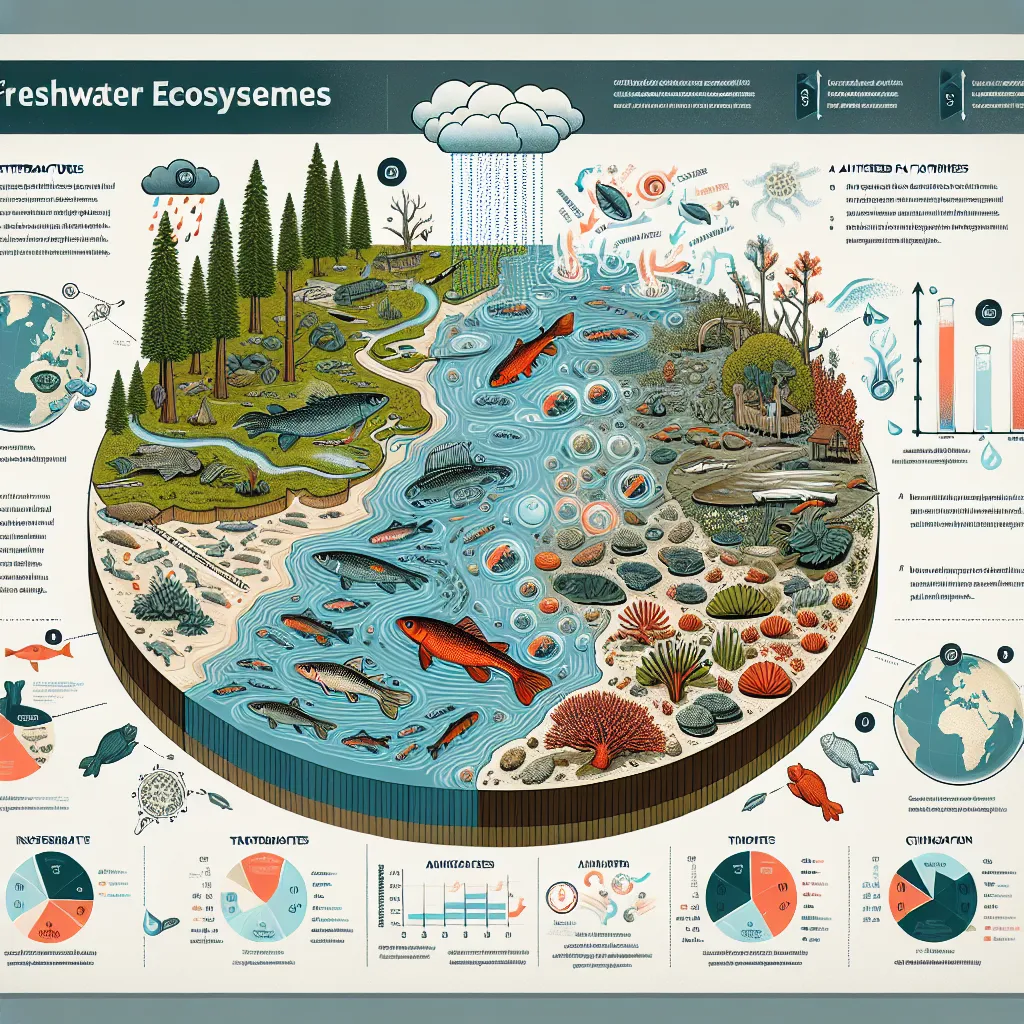As an experienced IELTS instructor, I’m excited to share a comprehensive IELTS Reading practice test focused on the crucial topic of “How climate change is affecting freshwater ecosystems.” This practice material will help you prepare for the IELTS Reading section while also enhancing your understanding of this important environmental issue.
Introduction
Climate change is one of the most pressing issues of our time, and its effects on freshwater ecosystems are particularly concerning. This IELTS Reading practice test will explore various aspects of this topic, challenging your reading comprehension skills while providing valuable insights into the environmental changes occurring in our freshwater systems.
 Climate change impact on freshwater
Climate change impact on freshwater
IELTS Reading Practice Test
Passage 1 – Easy Text
The Impact of Climate Change on Freshwater Ecosystems
Climate change is rapidly altering the planet’s freshwater ecosystems, which are vital for both human survival and the health of the environment. These ecosystems, including rivers, lakes, and wetlands, are experiencing significant changes due to rising temperatures and shifting precipitation patterns.
One of the most noticeable effects is the warming of water bodies. As air temperatures increase, so do water temperatures, leading to a range of consequences for aquatic life. Many species of fish and other aquatic organisms are adapted to specific temperature ranges, and even small changes can disrupt their life cycles, feeding patterns, and reproductive behaviors.
Another major impact is the alteration of water availability. Climate change is causing more frequent and severe droughts in some regions, while others are experiencing increased flooding. These extremes can lead to habitat loss, changes in water quality, and disruptions to the delicate balance of freshwater ecosystems.
The melting of glaciers and snow packs is also a significant concern. Many rivers rely on meltwater from these sources, especially during dry seasons. As glaciers recede and snowfall patterns change, the timing and volume of water flow in rivers are being altered, affecting both aquatic life and human water supplies.
Furthermore, climate change is influencing water chemistry. Rising temperatures can lead to increased evaporation, concentrating pollutants and reducing oxygen levels in water bodies. This can create challenging conditions for many aquatic species and potentially lead to algal blooms, which can be harmful to both wildlife and human health.
Wetlands, which play a crucial role in water purification and flood control, are particularly vulnerable to climate change. Rising sea levels threaten coastal wetlands with saltwater intrusion, while changing precipitation patterns can lead to the drying out of inland wetlands.
The impacts of climate change on freshwater ecosystems are not isolated; they have far-reaching consequences for terrestrial ecosystems and human societies that depend on these water resources. As these changes continue, it becomes increasingly important to monitor, understand, and develop strategies to mitigate the effects of climate change on our precious freshwater resources.
Questions 1-5
Do the following statements agree with the information given in the reading passage?
Write
TRUE if the statement agrees with the information
FALSE if the statement contradicts the information
NOT GIVEN if there is no information on this
- Climate change only affects large water bodies like oceans and seas.
- Warming water temperatures can disrupt the life cycles of aquatic species.
- All regions are experiencing increased flooding due to climate change.
- Melting glaciers and changing snowfall patterns affect river flow.
- Wetlands are immune to the effects of climate change.
Questions 6-10
Complete the sentences below.
Choose NO MORE THAN TWO WORDS from the passage for each answer.
- Climate change is causing more frequent and severe __ in some regions.
- The __ and volume of water flow in rivers are being altered by melting glaciers and changing snow patterns.
- Increased evaporation can lead to the concentration of __ in water bodies.
- __ can occur due to reduced oxygen levels and increased pollutants in water.
- Coastal wetlands are threatened by __ intrusion due to rising sea levels.
Passage 2 – Medium Text
Cascading Effects of Climate Change on Freshwater Biodiversity
The impacts of climate change on freshwater ecosystems extend far beyond simple temperature increases, creating a complex web of interactions that threaten biodiversity in these vital habitats. As global temperatures rise and precipitation patterns shift, freshwater environments are experiencing unprecedented changes that ripple through entire ecosystems, affecting species from microscopic algae to top predators.
One of the most significant challenges facing freshwater biodiversity is the alteration of thermal regimes. Many aquatic species have evolved to thrive within specific temperature ranges, and even small deviations can have profound effects. For example, cold-water fish species like trout and salmon are particularly vulnerable to warming waters. As temperatures rise, these species face increased metabolic stress, reduced reproductive success, and increased competition from warm-water species expanding into their habitats.
Climate change is also disrupting the delicate timing of life cycle events, a phenomenon known as phenological mismatch. Many aquatic insects, for instance, time their emergence to coincide with specific environmental cues, such as day length or water temperature. As these cues shift due to climate change, insects may emerge at times that no longer align with the availability of their food sources or the presence of their predators, leading to population declines and ecosystem imbalances.
Water level fluctuations, exacerbated by climate change, pose another significant threat to freshwater biodiversity. Extreme events such as prolonged droughts or severe floods can dramatically alter habitat availability and quality. During droughts, the concentration of pollutants increases, oxygen levels decrease, and habitats become fragmented, isolating populations and reducing genetic diversity. Conversely, floods can wash away crucial spawning grounds, disrupt feeding patterns, and introduce invasive species to new areas.
The chemistry of freshwater systems is also changing in response to climate change. Increased carbon dioxide levels in the atmosphere are leading to the acidification of freshwater bodies, mirroring the well-documented ocean acidification process. This pH shift can have far-reaching consequences, affecting the development of calcium-containing structures in organisms like mollusks and crustaceans, and altering the toxicity of pollutants in the water.
Moreover, climate change is facilitating the spread of invasive species in freshwater ecosystems. Warmer temperatures and altered flow regimes can create more favorable conditions for non-native species, allowing them to outcompete native flora and fauna. This can lead to homogenization of freshwater communities, reducing overall biodiversity and ecosystem resilience.
The cumulative effects of these changes are pushing many freshwater species to the brink of extinction. According to recent studies, freshwater ecosystems are among the most threatened on the planet, with extinction rates for freshwater species far exceeding those of terrestrial or marine species. This loss of biodiversity not only represents a tragedy in itself but also threatens the many ecosystem services that freshwater systems provide, from water purification to flood control.
Addressing these challenges requires a multi-faceted approach. Conservation efforts must focus on protecting and restoring freshwater habitats, creating corridors to allow species migration, and reducing other stressors such as pollution and overexploitation. Additionally, climate change mitigation efforts are crucial to slow the rate of change and give species and ecosystems the best chance to adapt.
As we continue to unravel the complex interactions between climate change and freshwater biodiversity, it becomes increasingly clear that the health of these ecosystems is inextricably linked to our own well-being. Protecting freshwater biodiversity in the face of climate change is not just an environmental imperative but a critical component of ensuring a sustainable future for all life on Earth.
Questions 11-14
Choose the correct letter, A, B, C, or D.
-
According to the passage, which of the following is NOT mentioned as an effect of rising water temperatures on cold-water fish species?
A) Increased metabolic stress
B) Reduced reproductive success
C) Increased competition from warm-water species
D) Improved hunting abilities -
The term “phenological mismatch” refers to:
A) The inability of species to adapt to new environments
B) The misalignment of life cycle events with environmental cues
C) The mismatch between predator and prey populations
D) The discord between water temperature and oxygen levels -
What is mentioned as a consequence of increased carbon dioxide levels in freshwater systems?
A) Increased algal growth
B) Higher water temperatures
C) Acidification of water bodies
D) Improved water clarity -
According to the passage, freshwater species extinction rates are:
A) Lower than terrestrial species
B) Equal to marine species
C) Higher than both terrestrial and marine species
D) Not mentioned in comparison to other ecosystems
Questions 15-19
Complete the summary below.
Choose NO MORE THAN TWO WORDS from the passage for each answer.
Climate change is causing numerous challenges for freshwater biodiversity. Rising temperatures are particularly problematic for (15) __ fish species, while changes in environmental cues are leading to (16) __ in the life cycles of aquatic insects. Water level fluctuations, including droughts and floods, can alter habitat availability and introduce (17) __ to new areas. The (18) __ of freshwater bodies is changing due to increased atmospheric carbon dioxide, affecting organisms with calcium-containing structures. These cumulative effects are pushing many freshwater species towards (19) __, threatening biodiversity and ecosystem services.
Question 20
Choose the correct letter, A, B, C or D.
- The main purpose of the final paragraph is to:
A) Summarize the effects of climate change on freshwater ecosystems
B) Propose solutions to address the challenges faced by freshwater biodiversity
C) Highlight the importance of freshwater ecosystems to human well-being
D) Criticize current conservation efforts
Passage 3 – Hard Text
Adaptive Strategies and Resilience of Freshwater Ecosystems in the Face of Climate Change
As the impacts of climate change on freshwater ecosystems become increasingly apparent, researchers and conservationists are turning their attention to understanding and enhancing the adaptive capacity and resilience of these vital systems. The complexity of freshwater ecosystems, with their intricate web of interactions between biotic and abiotic components, presents both challenges and opportunities in the context of climate change adaptation.
One of the key areas of focus is the concept of ecological resilience, defined as the ability of an ecosystem to absorb disturbances and reorganize while undergoing change so as to still retain essentially the same function, structure, identity, and feedbacks. In freshwater ecosystems, this resilience is often linked to biodiversity, with more diverse systems generally showing greater capacity to withstand and recover from climate-induced stresses.
Recent studies have identified several mechanisms through which freshwater ecosystems might adapt to changing climatic conditions. Phenotypic plasticity, the ability of an organism to alter its physiology, morphology, or behavior in response to environmental changes, is one such mechanism. For instance, some fish species have demonstrated the ability to adjust their thermal tolerance ranges in response to gradually increasing water temperatures, albeit within limits.
Evolutionary adaptation is another potential response to climate change. Given the rapid pace of current climate change, there is considerable interest in the potential for contemporary evolution – genetic changes occurring over relatively short timescales. Some freshwater species, particularly those with short generation times, may be able to evolve in response to new selective pressures imposed by climate change. However, the capacity for such rapid evolution varies greatly among species and is often limited by factors such as genetic diversity and population size.
Spatial dynamics also play a crucial role in the adaptive capacity of freshwater ecosystems. The ability of species to shift their ranges in response to changing conditions is a key adaptation strategy. However, the fragmented nature of many freshwater habitats, often exacerbated by human-made barriers, can limit this movement. Creating and maintaining connectivity between freshwater habitats is therefore a critical aspect of enhancing ecosystem resilience.
Another important consideration is the role of refugia – areas that remain relatively stable in the face of regional climate change. These refugia can serve as havens for species during periods of environmental stress and as sources for recolonization once conditions improve. Identifying and protecting potential climate refugia in freshwater ecosystems has become a priority for many conservation strategies.
The concept of ecosystem-based adaptation (EbA) is gaining traction as an approach to enhancing the resilience of freshwater ecosystems. EbA involves the use of biodiversity and ecosystem services as part of an overall adaptation strategy to help people adapt to the adverse effects of climate change. In freshwater contexts, this might involve restoring riparian vegetation to moderate water temperatures, managing water flows to mimic natural patterns, or protecting and restoring wetlands to enhance flood mitigation and water purification services.
Adaptive management practices are also being increasingly employed in the conservation of freshwater ecosystems. This approach involves iterative decision-making, with management strategies adjusted based on observed outcomes. Given the uncertainties associated with climate change impacts, such flexible and responsive management approaches are crucial.
The role of human communities in enhancing the resilience of freshwater ecosystems cannot be overstated. Engaging local communities in conservation efforts, incorporating traditional ecological knowledge, and promoting sustainable water use practices are all essential components of effective adaptation strategies.
However, it is important to note that there are limits to adaptation. Some changes may be too rapid or too extreme for ecosystems to adapt, leading to irreversible shifts in ecosystem structure and function. This underscores the critical importance of global efforts to mitigate climate change alongside adaptation measures.
As we continue to grapple with the challenges posed by climate change to freshwater ecosystems, it is clear that a multi-faceted, interdisciplinary approach is needed. By combining cutting-edge scientific research with innovative conservation strategies and community engagement, we can work towards enhancing the resilience of these vital ecosystems, ensuring their continued ability to support biodiversity and provide essential services in an uncertain climatic future.
Questions 21-26
Complete the sentences below.
Choose NO MORE THAN TWO WORDS from the passage for each answer.
-
The ability of an ecosystem to absorb disturbances while maintaining its essential characteristics is known as ecological __.
-
More diverse freshwater systems generally show greater capacity to __ and recover from climate-induced stresses.
-
The ability of an organism to alter its physiology, morphology, or behavior in response to environmental changes is called __ __.
-
The potential for species to evolve rapidly in response to climate change is referred to as __ evolution.
-
Areas that remain relatively stable during regional climate change and can serve as safe havens for species are called __.
-
The use of biodiversity and ecosystem services as part of a climate change adaptation strategy is known as __ -based adaptation.
Questions 27-30
Do the following statements agree with the information given in the reading passage?
Write
TRUE if the statement agrees with the information
FALSE if the statement contradicts the information
NOT GIVEN if there is no information on this
- All freshwater species have an equal capacity for rapid evolution in response to climate change.
- Creating connectivity between freshwater habitats is important for enhancing ecosystem resilience.
- Ecosystem-based adaptation always involves the relocation of species to new habitats.
- Adaptive management practices involve fixed strategies that do not change over time.
Questions 31-35
Choose the correct letter, A, B, C, or D.
-
According to the passage, which of the following is NOT mentioned as a mechanism for freshwater ecosystem adaptation to climate change?
A) Phenotypic plasticity
B) Evolutionary adaptation
C) Spatial dynamics
D) Genetic engineering -
The passage suggests that the ability of species to shift their ranges in response to climate change is:
A) Unlimited in all freshwater ecosystems
B) Often limited by habitat fragmentation
C) Unnecessary for ecosystem resilience
D) Only relevant for fish species -
Which of the following is described as a potential example of ecosystem-based adaptation in freshwater contexts?
A) Building concrete dams
B) Introducing non-native species
C) Restoring riparian vegetation
D) Increasing water extraction -
The role of human communities in enhancing freshwater ecosystem resilience is described as:
A) Insignificant
B) Detrimental
C) Essential
D) Not mentioned -
The passage concludes by emphasizing the need for:
A) A single, unified approach to freshwater conservation
B) Focusing solely on scientific research
C) Ignoring community engagement in conservation efforts
D) A multi-faceted, interdisciplinary approach to enhancing ecosystem resilience
Answer Key
Passage 1
- FALSE
- TRUE
- FALSE
- TRUE
- FALSE
- droughts
- timing
- pollutants
- Algal blooms
- saltwater
Passage 2
- D
- B
- C
- C
- cold-water
- misalignment
- invasive species
- chemistry
- extinction
- B
Passage 3
- resilience
- withstand
- phenotypic plasticity
- contemporary
- refugia
- ecosystem
- FALSE
- TRUE
- NOT GIVEN
- FALSE
- D
- B
- C
- C
- D
Vocabulary
Here are some challenging words from the passages along with their definitions:
- Phenological (adjective): Relating to the study of cyclic and seasonal natural phenomena, especially in relation to climate and plant and animal life.
Pronunciation: /ˌfiːnəˈlɒdʒɪkəl/


